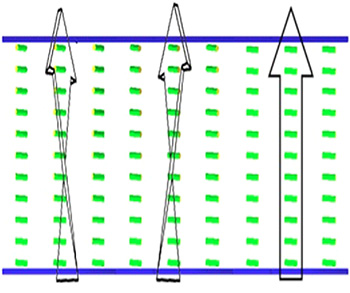
In the 3D-ORLCD, light is twisted in three different directions to make the image appear three-dimensional. Credit: Abhishek Kumar Srivastava
Researchers from the Hong Kong University of Science and Technology, China, have developed a new 3-D liquid crystal display (LCD) concept based on a bistable (zero-power) display that does not need power to maintain an image once it’s uploaded (Opt. Lett., doi: 10.1364/OL.39.006209). The new greyscale display, called a 3-D optically rewritable LCD (3D-ORLCD), is thin, energy-efficient and easy to manufacture and has potential applications in e-book readers, battery status monitors and credit card security measures.
The display consists of two polarized glass sheets—one is optically active, the other is passive—with liquid crystal molecules in the middle. There are no electrodes, as with traditional LCD displays, allowing for simple fabrication as well as making the screen thinner and decreasing its energy requirements.
An image is created on the screen via a flash of light. The flash passes through the polarized glass and alters the liquid crystal molecules in a specific way, revealing a picture. The crystals stay in place, thereby holding the image, until another flash is applied to change it. Creating a 3-D effect with the ORLCD is a one-step process. The researchers alter the polarization of the light going through the screen, dividing the image into three parts with different optic axes—0°, -45° and +45°. The exiting light is passed through a quarter-wave plate on top of the display. With a pair of Polaroid glasses, the viewer sees the image in three dimensions.
The authors state that since the screen only draws power when the image changes, it could potentially hold an image for years. The technology isn’t market-ready yet, but they are working to increase the refresh speed of their 3D-ORLCDs, as well as add color capabilities.
